For over two decades, Roger Federer entranced tennis fans with his artistry on the court. Flowing from one victorious season to the next, he collected 20 Grand Slam singles titles and spent over 300 weeks ranked as the number one men’s tennis player in the world. Throughout his storied career, Federer brought grace to a sport known for grueling physical battles.
Like a steady metronome, he dictated play from the baseline or nimble-footed at the net with impeccable timing and technique. Now in the twilight of his playing days, the documentary “Federer: Twelve Final Days” follows the beloved champion as he embarks on one last voyage on the ATP tour.
Directed by Asif Kapadia and Joe Sabia, “Twelve Final Days” is given unprecedented access to tag alongside Federer in the fortnight between his retirement announcement and the final match at London’s Laver Cup in 2022. Through candid interviews and behind-the-scenes moments, the film aims to provide tennis fans with an intimate look at one of the greatest athletes of the modern era.
With testimonies from Federer’s family, rivals, and contemporaries, it celebrates his indelible impact on his sport and the millions of adoring supporters worldwide. Yet as a story focused solely on the poignant bookends of Federer’s career, the documentary can feel somewhat slim and safe, leaving fascinated viewers wanting just a bit more insight into what made this exceptional champion tick both on and away from center court.
Reflections on a Legend’s Final Chapter
Federer: Twelve Final Days meticulously chronicles the fortnight leading up to tennis legend Roger Federer’s emotional farewell at the Laver Cup. Viewers are granted unprecedented access during this significant moment as the beloved champion prepares to step away from the sport he elevated for over two decades.
Directors Asif Kapadia and Joe Sabia follow Federer in the days after he announces his retirement, culminating in his final competitive doubles match partnered with rival-turned-friend Rafael Nadal. Across a mere 12 days, fans are treated to both joyous celebrations and heartfelt goodbyes between Federer and his peers.
By focusing solely on this narrow timeframe, the film achieves its goal of providing an intimate look at Federer’s retirement process. Scenes of him recording his announcement and subsequent reactions offer a window into the careful planning involved. Meanwhile, interactions with other legends who’ve arrived to honor Federer showcase the profound effect he’s had across generations.
These moments of camaraderie take the viewer right into the locker room to witness their genuine admiration and brotherly bonds firsthand. The final match itself presents a respectful, full-circle ending to Federer’s illustrious career alongside his greatest opponent.
However, confining the narrative to just the retirement period also limits how much insight is gained into what made Federer exceptional in the first place. While plenty of praise is heaped upon him, rare glimpses into his mindset and work ethic feel all too brief. Perhaps expanding slightly beyond these 12 days could have balanced celebratory tones with added context on Federer’s development and drive.
Similarly, focusing exclusively on the controlled buildup and ceremony surrounding his farewell may omit potentially fascinating layers to his personality and competitiveness revealed in defeat or adversity. Overall, it effectively honors Federer while leaving some wondering about the full scope of his story.
Seeing the Player Behind the Legend
Directors Asif Kapadia and Joe Sabia were granted unprecedented access to tennis great Roger Federer in the twilight of his illustrious career. This afforded intimate glimpses of the man behind the iconic image. While the documentary format limits a thorough examination of Federer’s play, it effectively illuminates his character.
Viewers are treated to Federer’s reflections in candid moments. He openly discusses confronting retirement as akin to facing death for elite athletes. This honest contemplation of change contrasts with his celebrated on-court composure. Similarly, he acknowledges strategically emulating rivals’ styles—aa uniquely thoughtful edge rarely seen in sports documentaries. Through these insights, Federer emerges as more multidimensional than his gracious public persona implies.
The film grants insight into Federer’s relationships and emotions. His bond with rival-turned-friend Rafael Nadal shines through tender scenes of reminiscence. Their dynamic exemplifies sportsmanship, surpassing victory or defeat. Genuine care for peers like Novak Djokovic is also conveyed, contradicting rumors of rivalry. Most profoundly, Federer’s vulnerability in farewell moments underscores his deep passion for the game that shaped his identity.
While focusing on Federer’s final days strengthens the narrative arc, it limits the examination of the ingredients of his success. Brief training sequences hint at perseverance and nuanced tactics but leave viewers wanting more. Earlier career watersheds receive cursory treatment. Expanding context around Federer’s evolution and defining rivalries could have balanced celebration with more substantive analysis.
Nevertheless, by showing Federer’s humanity, the film enhances fans’ connection to him. While not definitive, it offers a fittingly thoughtful tribute honoring both the athlete and the man.
Bonds Built on the Court
Much of Federer: Twelve Final Days focuses on Roger’s relationships with his rivals-turned-friends from the tennis world. While brief moments shine a light on his bond with Andy Murray and Novak Djokovic, it’s undoubtedly his connection with Rafael Nadal that comes through most strongly.
From the beginning, their on-court clashes thrilled fans with fast-paced shots and long rallies. Yet beneath the surface ran deep wells of respect for one another’s talent. As the documentary reveals, Roger first confided in Rafa about retiring, a sign of trust between them. Hearing this, Rafa broke down, showing a rare glimpse of his softer side.
Their warmth is sweet to witness. Reunited in London, laughter and chatter flow easily, despite years spent facing each other across the net. But it’s in quieter moments that their friendship’s strength becomes clear. Reminiscing about classic matches, Roger’s gaze grows tender as he talks of “almost touching through the ball.” You sense their bond runs far deeper than any trophy or record.
All reach a crescendo when the pair take to the doubles court for the final time. The playful competitive spirit still flickers, yet underneath lies melancholy, both knowing the end of an era is near. Afterward’s mingled tears say more than any words ever could. As the championships fade into history, their hug confirms a connection that none but teammates and opponents could truly understand.
Bonds like theirs don’t form overnight. Only through long years of testing one another to the limits could Roger and Rafa forge a friendship as tightly knit yet gently caring as the strings of their rackets. Their story shows that even the fiercest of rivals can find respect, compassion, and an unbreakable bond as the bonds they built upon the court.
The Ins and Outs of Filming a Legend
Directors Asif Kapadia and Joe Sabia had an immensely challenging task: capturing the final moments of one of tennis’s most graceful icons. Did Federer: Twelve Final Days do Roger Federer justice? Let’s take a look behind the scenes.
Firstly, the access is truly remarkable. We see Federer in candid settings rarely witnessed, from recording retirement messages to greeting supporters at the Laver Cup. Where some documentaries rely on talking heads, Kapadia takes us directly into the action. Certain moments, like Federer prepping for his doubles match, feel intensely intimate.
Though not on the scale of Kapadia’s other athletic profiles, like Senna, the footage quality remains quite high. Close-ups bring crispness to portraits of Federer expressing emotion. Court-level angles during the final match abandon formulaic broadcasts for a fresh perspective. Relevant clips illustrate Federer’s skill without distraction.
Compared to explosive subjects like Winehouse, Kapadia adopts a calmer approach with Federer. This fits his subject’s controlled persona but risks appearing restrained. Occasional insights into Federer’s competitive mind show glimpses of a figure far more multifaceted than his public face. Deeper dives could have augmented our understanding.
Still, judiciously selected archival clips do uplift the narrative. Spotlighting prime rivals like Nadal and Djokovic serves to honor their shared legacies, with their friendship emerging as a heartwarming throughline. Stylistic flashiness isn’t necessary for a fitting farewell to Federer’s elegant career.
In the end, Kapadia’s film is respectful yet leaves room to explore Federer further. With innovative access and careful handling of its regal subject, The Ins and Outs of Filming a Legend brings viewers ringside for a touching tenure’s end.
Federer’s Final Bow
Tennis aficionados have long known Roger Federer as the sublime maestro who made the court his canvas. But for many viewers, Federer: Twelve Final Days brings this legend fully into focus. The documentary sheds light on Federer’s immense impact by bearing witness to his graceful farewell.
Across two decades, Federer redefined excellence with his fluid artistry. The film underscores this by featuring luminaries lauding his “Baryshnikov-like” balletic movements and unparalleled skills. Through clips of Federer at his magnificent peak, directors Kapadia and Sabia transport audiences to the awe firsthand devotees experienced. This glimpse into his awe-inspiring talent cements Federer’s status as the sport’s measuring stick.
Yet the film especially honors Federer by framing the end of his era. Arriving as rivals Nadal and Djokovic also step back, its timing underscores a paradigm shift. The footage from Federer’s final competition draws out the poignancy as the changing of tennis’ guard commences. In these scenes and others showing comrades reminiscing together, the documentary celebrates Federer while bidding adieu to an illustrious cycle.
Most profoundly, Federer’s farewell addresses fans who cherished this champion. The intimate access grants viewers their own moment to applaud and understand Federer’s journey. From the announcement to the last match, the film walks with Federer, enabling devotees to share in both the triumph and heartache of his finale. With grace and eloquence, Federer: Twelve Final Days pays homage to the maestro through a masterful, moving act of tribute.
Federer: A Fitting Finale
While Kapadia’s documentary has its flaws, it delivers a deserving sendoff for an all-time great. The film shines in capturing tender moments between Federer and his peers that feel genuinely moving. You really see the mutual affinity shared by Federer, Nadal, and Djokovic during their heartfelt goodbyes. Beyond the on-court fireworks, their friendships run deep. You also get a sense of Federer’s witty charms in lighter locker room scenes.
At the same time, the documentary could have dug deeper. We learn little about specific matches or rivalries that defined Federer’s legacy. More insight into his training and struggles may have added layers. And the result feels a touch too controlled at times. But given its purpose as a family portrait of Federer’s farewell, such shortcomings are understandable.
Overall, this serves as a fitting tribute for Maestro’s thousands of devoted fans. While not perfect, the film celebrates Federer’s grace and delight with which he brought millions. We relive cherished moments and share in the emotions of his final bow. For anyone who marveled at Federer in his prime, these intimate farewell sights and sounds are a gift. Though his storied career is over, this documentary ensures Federer’s greatness will live on in memories for years to come.
The Review
Federer: Twelve Final Days
In the end, Federer: Twelve Final Days succeeds in what matters most: paying richly earned homage to one of sport's all-time-class acts. While not the deepest documentary, it effectively transports fans back to Federer's magnificent peak and allows us to share in his retirement ceremonies. We see why the Swiss Maestro was beloved the world over and understand better the indelible mark he left on tennis. For that reason alone, any Federer fan will find value in reliving these final days.
PROS
- Provides intimate access to Federer's farewell ceremonies and interactions with rivals.
- Captures emotional highlights like Federer and Nadal's post-match moment together.
- Gives fans a chance to relive Federer's achievements and say goodbye.
CONS
- Lacks depth on Federer's career development and specific matches
- Feels overly controlled and coordinated at times.
- Could have examined Federer's mindset and training more closely.





















































